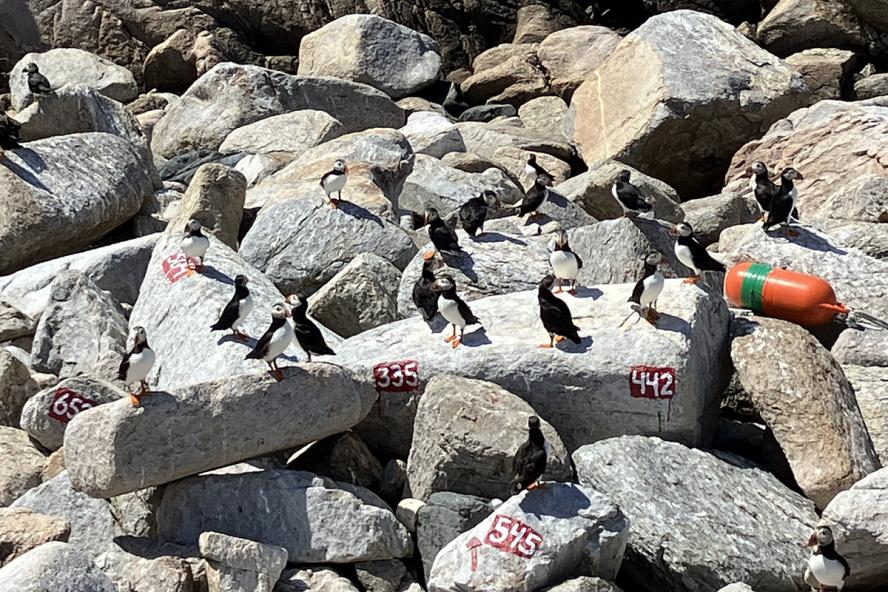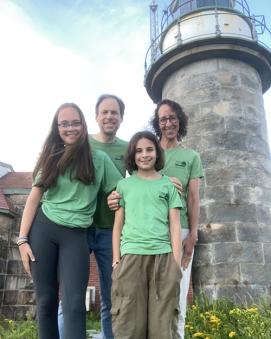-
About
- Leadership & Faculty
- News & Events
-
Academics
- Graduate
- Advanced Clinical Training
- Continuing Education
- Academic Departments
- Academic Offices
- Simulation Experiences
-
Student Life
- Offices
-
Research
-
Hospitals & Clinics
- Emergency Care
- Hospital Services
-
Community Outreach
- Volunteer
Project Puffin “Island-sitter”
Former faculty member shares her contributions to conservation of rare seabirds during 50th anniversary of Project Puffin’s inception

This year the National Audubon Society’s Seabird Institute is celebrating the 50th anniversary of Project Puffin, a Maine-based seabird conservation and restoration project. Cummings School of Veterinary Medicine caught up with former faculty member of the Master of Conservation Medicine program, Rebecca Harris, Ph.D., AG01, who previously worked for the Project and recently served as an island-sitter to allow current Project members some time off.
What drew you to your involvement with Project Puffin?
I took an ornithology course in college and my professor had worked as an intern on Project Puffin. The idea of living on a remote island surrounded by seabirds sounded ideal, so I applied to be an intern. I had spent a week on Hog Island at a family camp in high school, so I knew the area (Project Puffin base is directly across from Hog Island in Bremen, Maine).
How did that inspire you to continue with the Project and later become a supervisor?
My experience in the summer of 1994 on Matinicus Rock, Eastern Egg Rock, and Stratton Island, was incredible. I was hooked. I loved island life—the remoteness, the mad cacophony of being surrounded by seabirds whirling and diving and pooping on you, the comradery of living in close quarters with a handful of like-minded people.
I learned a lot about hands-on research and was inspired by the success story of restoration that is Project Puffin. To be immersed in that world and solely focused on birds, daily chores, building maintenance—while hard work, it was also freeing. We had a lot of down time when the weather was bad, and back in the days before cell phones we entertained ourselves by creating videos, doing “small crafts” on “small craft advisory” days, and making and playing instruments (I made a flute out of a PVC pipe).
Creativity was mandatory (I once fixed a leak in the Matinicus Rock lighthouse chimney using an upside-down paint tray), and I was inspired by a wonderful mentor, Sue Schubel, who was the supervisor on Matinicus for my first two seasons. She went to California for my last season to do a seabird restoration project, so I became Matinicus Rock supervisor in her absence. She still works for the Project today, doing educational programs in schools and running almost all the island logistics, maintenance, and creating decoys for seabird restoration projects worldwide.
How did your Project Puffin experience shape your career?
The Project entirely formed my career. I was determined to do something in bird conservation once I had the experience on the islands. I earned my Ph.D. at Tufts in the Biology Dept after that, focusing on songbirds in the Maine woods and forestry impacts.
My connection to Tufts continued because upon graduating I wanted to do something applied, not just academia, so I reached out to Mark Pokras, then director of Tufts Wildlife Clinic, and created a position for myself at Cummings School. I co-founded SEANet (Seabird Ecological Assessment Network) with Mark and Flo Tseng, who had just started there. We ran that project entirely on grant funding for four years before I left and became the director of Mass Audubon’s Coastal Waterbird Program (CWP). The CWP brought me back to the field (in this case the beach), where I could direct on-the-ground conservation and management of rare species and make an impact. It was the sort of job I had hoped to obtain when I was starting out as an intern on Project Puffin, and I maintained a lot of my contacts in the seabird/shorebird world throughout my time managing SEANet, so it was all connected.
How has Project Puffin evolved since you started as an intern?
Back when I was working there, the five or so islands in the Gulf of Maine comprised the project. The expansion to other parts of the world started in 1996 with the California murre restoration. Then it became clear the technique of social attraction for seabirds could be useful worldwide, with many species for different reasons—whether trying to “move” a colony of albatrosses off a runway or build new colonies of endangered terns on remote islands.
An international team of interns was added, so that there could be an exchange of ideas and information from other parts of the world. Sadly, climate change was not too much on our minds back in the ’90s, but now is an enormous part of the data collected. The warming waters of the Gulf of Maine has a direct impact on the types and amounts of fish brought in for chick provisioning. It is possible to directly correlate sea surface temperature with productivity (average number of chicks fledged per pair) each season (of puffins, terns, etc.).
What does the Project mean to you? To coastal waterbirds? To environmental activism?
To see the changes brought to the Gulf of Maine and beyond in terms of seabird restoration over 50 years is very heartening. It is the same kind of success story that I was a part of in Massachusetts with piping plovers when I was the director of the Coastal Waterbird Program.
There are now over 1,200 pairs of piping plovers nesting in Massachusetts. When I was working on the CWP it was about 800 pairs, and in 1986 when they were listed on the Endangered Species Act, about 120 pairs. Not only are the impacts of our actions seen in the numbers and successes of rare birds, but in the numbers of interns and students that go on to do great things in conservation because they started with Project Puffin.
Thousands of interns have gotten their start the same way I did, and the impacts of that are far reaching. We also share this kinship as “Puffineers,” even if we’ve never met. I’ve kept in touch with many of my former coworkers, much as I’ve kept in touch with former MCM students. I’ve always felt that one of the most powerful things about MCM or any small graduate program or internship project: your colleagues become your future coworkers and collaborators. For instance, I texted my former supervisor from nearly 30 years ago and asked, ‘Can I island-sit?’ and she made the logistics work to get a family of four to a remote island for five days!
What were the reactions to island-sitting for you and your family?
It was an experience my kids will never forget and one we hope to do again. I think both Abbie (13) and Sadie (10) were completely won over by the experience—they really didn’t want to leave. There is something very special about being on such a remote island (Matinicus Rock) and seeing no other humans. I think the vastness of the awe (in the birds, the island, the beauty) made us all healthier, even in our interactions with each other.
To be up close with puffins, terns, and guillemots brings a level of appreciation. I think my kids were both intrigued by the idea that they could one day be interns on Project Puffin and return to do actual work. We did some puffin band resighting in the blinds, but otherwise our workload was rather light. Abbie spent quite a long time in blinds observing the puffins and photographing them.
The 50th anniversary exhibit in the Puffin visitors’ center in Rockland [Maine] shows a map of the world depicting many conservation projects directly related to this one (seabird social attraction and reintroduction), and there are countless other projects that have begun because of Project Puffin.
(Right Photo: Former Cummings School faculty member Rebecca Harris spent five days island-sitting for Project Puffin with husband Fred and daughters Abbie (13) and Sadie (10). Credit: Abbie Harris)
Project Puffin actively collaborates with Cummings School graduate students and welcomes them to develop personalized projects in conjunction with the larger National Audubon Seabird Institute. Although she has shifted her career to serve as the town clerk in Boxborough, Massachusetts, Harris welcomes mentoring students in the MCM program.
Working Toward Impacting the Environment
Cummings School’s M.S. in conservation medicine uses a One Health approach to educate and train students how to make an impact on the environment and ecosystem.
Department:
M.S. in Conservation Medicine
